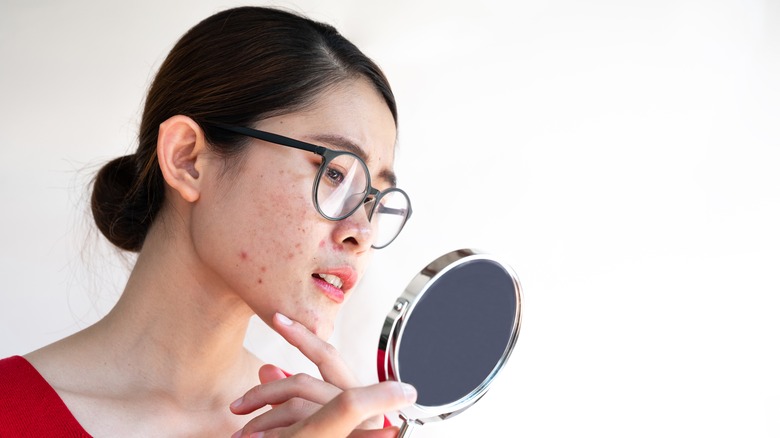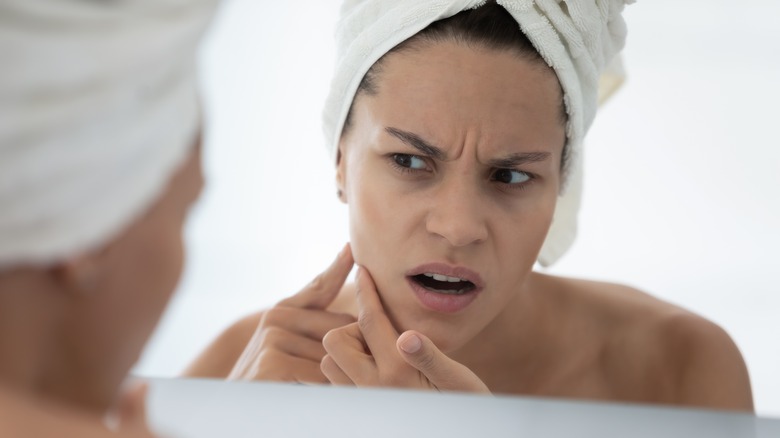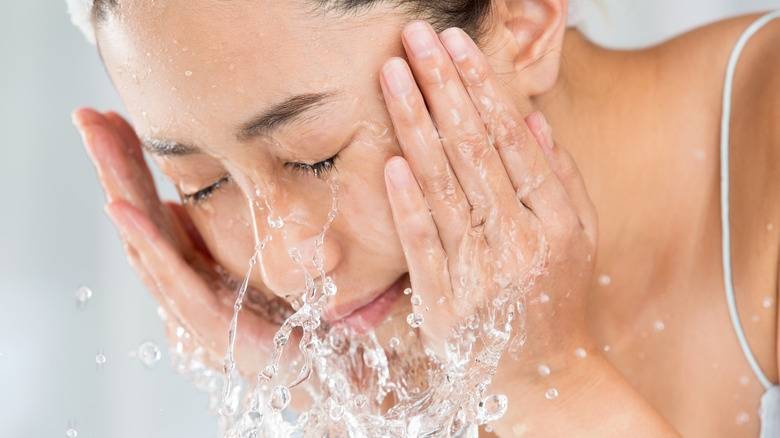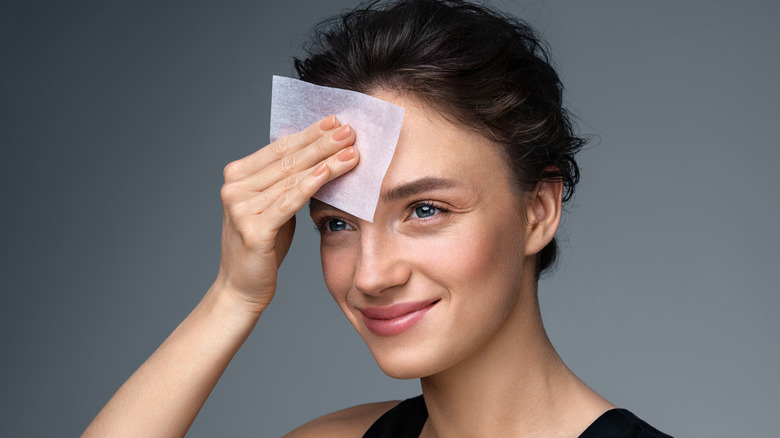If You Keep Breaking Out In The Same Spot, This Could Be Why
If you keep having pimples pop up in the same areas over and over, you know how painful and annoying it can be. You're doing all the things you're supposed to do like cleansing and moisturizing. Why won't they just go away and never return?
The key to understanding — and preventing — recurrent pimples is first of all to understand what they are and why they develop. The Cleveland Clinic explains that acne occurs when your skin's oil glands become clogged or inflamed.
Your oil glands can become clogged, they explain, by either increased oil production or abnormal keratin, a protein that is part of your skin, hair, and nails. Clogged pores can then become inflamed due to bacteria commonly found on your skin. DermNet NZ further explains that certain species of bacteria, including Cutibacterium acnes and Staphylococcus epidermidis, are the usual culprits involved in skin breakouts. The number of these bacteria, as well as malassezia yeasts, greatly increases on the skin during puberty.
Not too surprisingly, teenagers are the most prone to acne breakouts, according to the Cleveland Clinic. However, adults and even babies can have pimples.
Now that we understand what causes pimples, let's take a look at why they might keep plaguing us in a particular location.
Your hormones are surging
Healthline writes that hormonal acne is related to fluctuations in your hormones. This is one reason why teens so commonly have pimples as they go through puberty.
Women can also have acne breakouts associated with their menstrual period. This is due to the fluctuations that occur in their hormones. Some women will also develop acne as they go through menopause, possibly due to the fact that their estrogen levels are declining. The high levels of male hormones that are associated with PCOS (polycystic ovarian syndrome) can also cause skin problems.
Healthline notes that during puberty, people will often have pimples in the T-zone: the T-shaped area comprised of your forehead, nose, and chin. During adulthood, however, it is more typical to have breakouts around your jawline.
Hormonal acne is sometimes cystic, meaning that it forms deep inside the skin and does not come to a head. However, hormonal breakouts can also involve blackheads, whiteheads, and smaller pimples.
You're using the wrong products on your skin
According to the American Academy of Dermatology, you might also be experiencing frequent acne breakouts because you are using the wrong skin care, hair care, or makeup products. If these products contain oil or other skin-clogging ingredients, they can cause your pores to become clogged, triggering the development of pimples. To remedy this problem, they suggest looking for labels that say something like "non-comedogenic" or "won't clog pores."
They do caution, however, that even if you are using non-clogging products, you can run into trouble if you share makeup or makeup applicators with other people. Bacteria, oil, and dead skin cells can be transferred from one person to another, which can still end up clogging your pores.
Finally, they suggest that you don't cleanse your skin too often or use products that leave it too dry, like astringents or rubbing alcohol. This can irritate your skin and make you even more prone to pimples.
Something is touching your face
If you keep getting acne on a particular area of your face or body, it may be helpful to consider whether there is something that is regularly touching that area. Verywell Health writes that there is a type of acne called acne mechanica that may be to blame. Basically, acne mechanica is acne that is caused by friction, rubbing, pressure, or heat on the skin.
Athletes are very prone to acne mechanica since they often wear helmets, hats, and sweatbands. However, even tight-fitting bras and clothing can trigger it. The common factor in all of these is that there is something that is trapping heat and moisture against the skin, which can cause the pores to become blocked. Further friction can irritate pores and trigger the formation of pimples.
Unlike regular acne, acne mechanica will probably clear up if you remove whatever is causing the irritation.
You have an oily T-zone
If you keep getting acne on your forehead, nose, and chin — what is often called the "T-zone" — it may boil down to the fact that you have a lot more oil-producing glands in this area. It is also an area where sweat can build up and make more oil accumulate, according to Practo, even if you are not otherwise prone to oily skin. They also note that the pores in this area are naturally larger than pores in other parts of your face. Unfortunately, this can all add up to a greater tendency for breakouts in the center of your face.
The Cleveland Clinic, however, says there might be one exception to this rule: pimples that are located along your hairline. Certain hair care products like dry shampoos or mousses can be very waxy. If they build up along the hairline this can clog pores, leading to breakouts.
You're sweating a lot
According to Well+Good, if you have back or chest acne, it may be a result of yeast. WebMD explains that fungal acne is not actually acne. It is a condition called pityrosporum folliculitis. It is caused by the fungal species Malassezia and occurs in areas where there is a lot of oil produced, like the back or chest. Sweating can set up the right conditions for this species to thrive, leading to inflamed and infected hair follicles that resemble acne.
WebMD notes that exercise, along with tight equipment and uniforms, can set up the perfect hot, moist conditions for fungal growth.
Getting the right diagnosis is important in treating this type of breakout since it requires a different treatment from your run-of-the-mill acne breakout. However, telltale signs like very itchy skin; clusters of small, red bumps; location on back, chest, neck, or arms; and a lack of response to acne treatment can all point to a fungal infection as being the cause for your breakouts.






